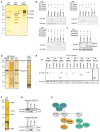Mapping the NPHP-JBTS-MKS protein network reveals ciliopathy disease genes and pathways
- PMID: 21565611
- PMCID: PMC3383065
- DOI: 10.1016/j.cell.2011.04.019
Mapping the NPHP-JBTS-MKS protein network reveals ciliopathy disease genes and pathways
Abstract
Nephronophthisis (NPHP), Joubert (JBTS), and Meckel-Gruber (MKS) syndromes are autosomal-recessive ciliopathies presenting with cystic kidneys, retinal degeneration, and cerebellar/neural tube malformation. Whether defects in kidney, retinal, or neural disease primarily involve ciliary, Hedgehog, or cell polarity pathways remains unclear. Using high-confidence proteomics, we identified 850 interactors copurifying with nine NPHP/JBTS/MKS proteins and discovered three connected modules: "NPHP1-4-8" functioning at the apical surface, "NPHP5-6" at centrosomes, and "MKS" linked to Hedgehog signaling. Assays for ciliogenesis and epithelial morphogenesis in 3D renal cultures link renal cystic disease to apical organization defects, whereas ciliary and Hedgehog pathway defects lead to retinal or neural deficits. Using 38 interactors as candidates, linkage and sequencing analysis of 250 patients identified ATXN10 and TCTN2 as new NPHP-JBTS genes, and our Tctn2 mouse knockout shows neural tube and Hedgehog signaling defects. Our study further illustrates the power of linking proteomic networks and human genetics to uncover critical disease pathways.
Copyright © 2011 Elsevier Inc. All rights reserved.
Figures







References
-
- Chang B, Khanna H, Hawes N, Jimeno D, He S, Lillo C, Parapuram SK, Cheng H, Scott A, Hurd RE, et al. In-frame deletion in a novel centrosomal/ciliary protein CEP290/NPHP6 perturbs its interaction with RPGR and results in early-onset retinal degeneration in the rd16 mouse. Hum Mol Genet. 2006;15:1847–1857. - PMC - PubMed
-
- Corbit KC, Aanstad P, Singla V, Norman AR, Stainier DY, Reiter JF. Vertebrate Smoothened functions at the primary cilium. Nature. 2005;437:1018–1021. - PubMed
Publication types
MeSH terms
Substances
Supplementary concepts
Grants and funding
- CA112369/CA/NCI NIH HHS/United States
- KL2RR025015/RR/NCRR NIH HHS/United States
- R01-EY11298/EY/NEI NIH HHS/United States
- DK090917/DK/NIDDK NIH HHS/United States
- R01NS064077/NS/NINDS NIH HHS/United States
- R01 CA112369/CA/NCI NIH HHS/United States
- R01 AR054396/AR/NIAMS NIH HHS/United States
- R01 GM095941/GM/NIGMS NIH HHS/United States
- GM07365-33/GM/NIGMS NIH HHS/United States
- T32 GM007365/GM/NIGMS NIH HHS/United States
- DK1068306/DK/NIDDK NIH HHS/United States
- R01 EY011298/EY/NEI NIH HHS/United States
- T32 HL007121/HL/NHLBI NIH HHS/United States
- HHMI/Howard Hughes Medical Institute/United States
- R01 DK068306/DK/NIDDK NIH HHS/United States
- MOP-102758/CAPMC/ CIHR/Canada
- R01-EY017168/EY/NEI NIH HHS/United States
- KL2 RR025015/RR/NCRR NIH HHS/United States
- K08 DK071108/DK/NIDDK NIH HHS/United States
- RC4 DK090917/DK/NIDDK NIH HHS/United States
- DK1069274/DK/NIDDK NIH HHS/United States
- DK071108/DK/NIDDK NIH HHS/United States
- R01 EY017168/EY/NEI NIH HHS/United States
- R01 NS064077/NS/NINDS NIH HHS/United States
- R01-AR054396/AR/NIAMS NIH HHS/United States
LinkOut - more resources
Full Text Sources
Other Literature Sources
Medical
Molecular Biology Databases

